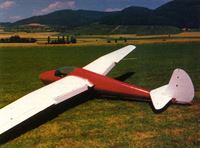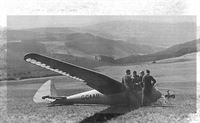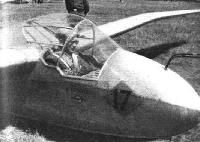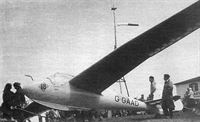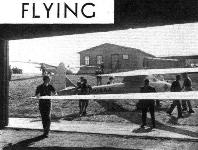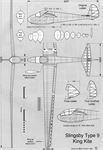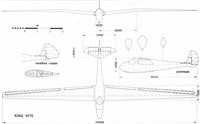
M.Simons The World's Vintage Sailplanes 1908-45
THE KING KITE
The King Kite was an advanced sailplane for its time but was dogged by bad luck. Mungo Buxton was one of the few designers who appreciated the importance of speed performance for a cross-country sailplane. His choice of aerofoil section showed that he was aiming at a good glide at high airspeeds. He selected the NACA 23021 profile, wind tunnel test results on this series having recently been published. It was very thick, 21% of the chord in depth, not highly cambered, and to the inexperienced eye almost symmetrical. It would develop low profile drag at high airspeeds. Buxton planned for flaps so that the profile could be altered, when circling in a thermal, to a form more suitable for this flight condition. The 230 series had an advantage in that they yielded very low pitching and wing-twisting moments, hence at high speeds would be less inclined to twist the wings and load the tailplane. The profile also had a characteristic, very sharp and sudden stall. It was decided that the aerofoil should be gradually changed toward the tips, to the well-proven NACA 4415, which had a benign stall. Protection against tip stalling was further provided by laying out the wing for a washout angle of three degrees. The ribs were closely spaced to preserve a good contour, and the whole surface back to the rear spar was covered with plywood to give more than usual torsional stiffness.
The fuselage was rather short, but the cockpit was comfortable with its good transparent canopy and large instrument panel. The wing loading was high by British standards.
Before the design had progressed far Buxton was obliged by RAF duties to hand over the bulk of the work to the Slingsby team. Most of the subsequent design and stressing was done by Peter Shaw, a well-qualified engineering graduate, assisted by J. S. Sproule.
The first flight took place early in April 1937. Everyone was in a hurry. The British Gliding Association wanted to send three King Kites to the International Competitions at the Wasserkuppe, in the summer. Philip Wills was impressed at first, but then came the spin tests, which proved almost fatal. He initiated a spin and recovered normally. Nothing led him to expect trouble but when he let the second spin develop fully and attempted to straighten out, the King Kite went on spinning. Nothing would bring about recovery and he decided to use his parachute. The canopy jettisoned, he tried repeatedly to jump clear but each time was thrown violently back into the cockpit, the glider still spinning. A last stupendous and desperate effort had Wills half out of the cockpit, hanging out over the nose of the glider. Again he was hurled back by the centrifugal forces but this time the aircraft, as a result of the violent changes of trim, stopped spinning and Wills found himself still in the glider, half inverted, with barely enough height to recover and make a shaky landing.
Hastily, a new taller rudder was fitted, then again a larger one, so that the King Kite could at least be made to recover from a spin. Three were sent to the Wasserkuppe with enormous rudders, but the initial launch on the first contest day saw one of the King Kites stall straight off the bungee to fall heavily down the slope, fortunately without injury to the pilot, P. M. Watt. The Germans rushed the damaged sailplane to their workshops.
Obviously something was seriously wrong. The cause of the trouble was not discovered until some years later. Fred Slingsby was carrying out an inspection of a King Kite when it occurred to him to check the wing incidence across the span. This convinced him that the three degrees washout intended by the designers had been reversed in the workshops, the wing having three degrees of wash-in! This, together with the bad stall of the aerofoil, would have accounted for the dangerous spinning characteristics. The wingtip stalled before the wing root, so a wing drop and spin were almost inevitable at low speeds.
One of the King Kites flew again in the immediate postwar period but in June 1946 it broke up in the air, killing its pilot, at the Long Mynd. The cause was attributed to glue failure. Probably the sailplane had been stored in damp conditions. The only surviving King Kite, painted bright training yellow with RAF roundels, appeared but did not fly at the first British National Championships after the war in 1947.
Technical data:
King Kite: Span, 15.50 m. Wing area 13.6 sq. m. Aspect ratio 18. Empty weight, 195 kg. Flying weight, 282 kg. Wing loading, 19 kg/ sq m. Aerofoils, NACA 23021 at root, tapering to NACA 4415 at the tip with 3 degrees washout as designed. Best glide, estimated. 1 : 25.
- M.Simons The World's Vintage Sailplanes 1908-45
Фотографии
-
Aeroplane Monthly 1993-06 / M.Simons - Sling's sailplanes (9)
David Jones’s new King Kite on aero-tow at Bourges during the 1988 Vintage Glider Club Rally. His Kite has entirely new wing profiles but otherwise is as close as possible to the original.
-
Aeroplane Monthly 1993-06 / M.Simons - Sling's sailplanes (9)
David Jones’s King Kite at the 1991 Vintage Glider Club Rally. Note the lowered flaps.
-
GL / M.Simons - The World's Vintage Sailplanes 1908-45 /Kookaburra/
The prototype with the second rudder tried, much taller than the original but still inadequate.
-
Aeroplane Monthly 1993-06 / M.Simons - Sling's sailplanes (9)
Регистрационный номер: G-GAAB [2] John Neilan chats with his crew on the Wasserkuppe, Germany in July 1937. The registration letters on the King kite were added only for the purpose of international travel.
There is something specially attractive about sailplanes on their native heath. On photo is one of the King Kites with a background of Fulda Valley; Mr. J. C. Neilan, one of the pilots of the machine, is second from the left in the group. -
Flight 1937-07 / Flight
Mr. G. O. Smith in one of the new King Kites.
-
GL / M.Simons - The World's Vintage Sailplanes 1908-45 /Kookaburra/
Регистрационный номер: G-GAAC G-AAAC with the flaps fully down and the very large rudder.
-
Aeroplane Monthly 1993-06 / M.Simons - Sling's sailplanes (9)
Регистрационный номер: G-GAAD, BGA304 The King Kite BGA 304 at the 1937 Wasserkuppe meeting. Shortly after this photograph was taken G-GAAD was a heap of wreckage after spinning in. Pilot Willy Watt escaped unhurt.
-
GL / M.Simons - The World's Vintage Sailplanes 1908-45 /Kookaburra/
Регистрационный номер: G-GAAB [2] The King Kite G-GAAB flying in 1937.
-
Flight 1937-07 / Flight
INTERNATIONAL: A scene at the Wasserkuppe on the first day of the International Gliding Competition. In the foreground can he seen Mrs. Ronald Price at the wing tip of her King Kite, while behind is the Hjordis, which is being handled by Messrs. P. A. Wills and J. C. Neilan.
Другие самолёты на фотографии: Buxton Hjordis - Великобритания - 1935
-
Aeroplane Monthly 1993-06 / M.Simons - Sling's sailplanes (9)
Slingsby Type 9 King Kite
- Фотографии

